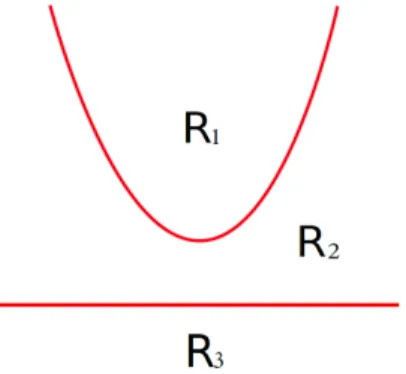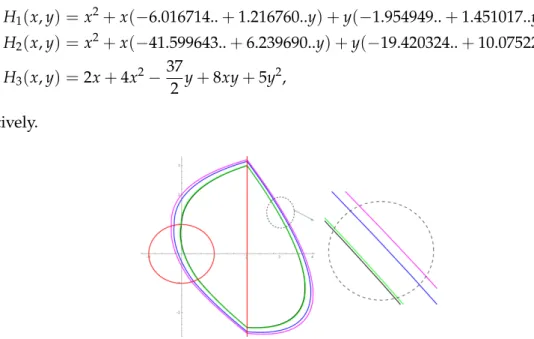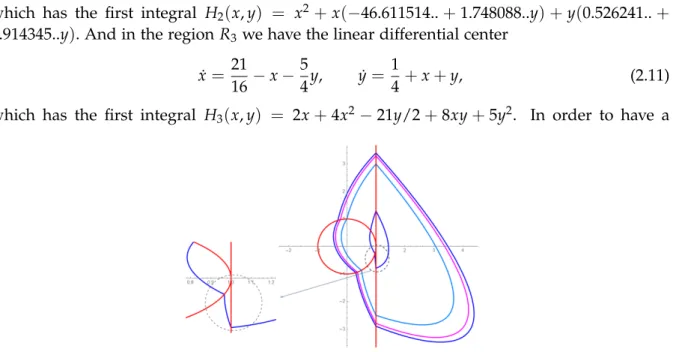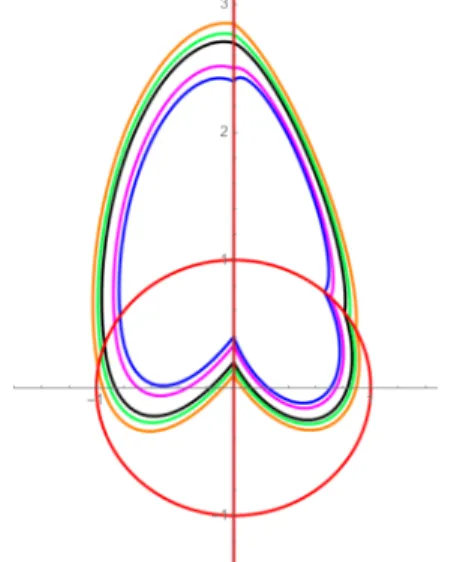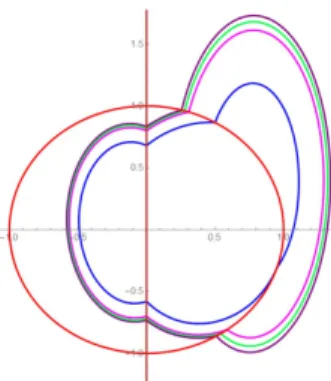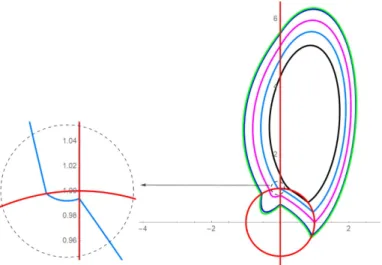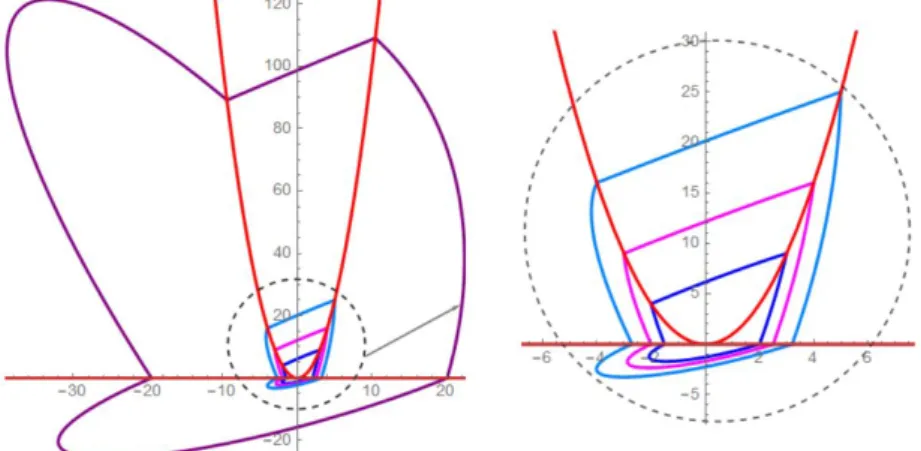Crossing limit cycles for piecewise linear differential centers separated by a reducible cubic curve
Jeidy J. Jimenez
1, Jaume Llibre
B2and João C. Medrado
31Universidade Federal do Oeste da Bahia, Bom Jesus da Lapa, 46470000, Bahia, Brasil
2Departament de Matemàtiques, Universitat Autònoma de Barcelona, Bellaterra, Barcelona, 08193, Catalonia, Spain
3Instituto de Matemática e Estatística, Universidade Federal de Goiás, Goiânia, 74001-970, Goiás, Brazil
Received 27 August 2020, appeared 5 April 2020 Communicated by Gabriele Villari
Abstract. As for the general planar differential systems one of the main problems for the piecewise linear differential systems is to determine the existence and the maxi- mum number of crossing limits cycles that these systems can exhibit. But in general to provide a sharp upper bound on the number of crossing limit cycles is a very difficult problem. In this work we study the existence of crossing limit cycles and their distribu- tion for piecewise linear differential systems formed by linear differential centers and separated by a reducible cubic curve, formed either by a circle and a straight line, or by a parabola and a straight line.
Keywords: discontinuous piecewise linear differential centers, limit cycles, conics.
2010 Mathematics Subject Classification: 34C05, 34C07, 37G15.
1 Introduction and statement of the main results
The discontinuous piecewise differential systems arose from the study of nonlinear oscilla- tions by Andronov, Vitt and Khaikin in [1]. And nowadays the qualitative theory of the discontinuous piecewise differential systems is a matter of great interest in the mathematical community because these systems arise naturally in the modeling of several real phenomena and processes for instance in electronics, mechanics, economy, biology, neuroscience etc., see [3,4,10,13,21,23] and references quoted therein.
One of the main problems in the qualitative theory of the discontinuous piecewise dif- ferential systems is to determine the maximum number of crossing limits cycles that these systems can have and their distribution. In this work we study the crossing limit cycleswhich are periodic orbits isolated in the set of all periodic orbits of the piecewise linear differential system, which only have isolated points of intersection with the discontinuity curve.
We recall that the 16th Hilbert’s problem requests for the maximum number of limit cycles that can have a polynomial differential system in R2 in function of the degree of the system,
B Corresponding author. Email: jllibre@mat.uab.cat
see [11,12]. Then the problem of establishing a sharp upper bound on the number of crossing limits cycles for the class of planar piecewise linear differential systems can be considered as an extension of the 16th Hilbert’s problem to this class and is in general a very difficult problem, because there are few developed techniques. In the plane the class of piecewise linear differential systems separated by a straight line is apparently the simplest class to study, and has been studied in several papers, see [2,5–9,16,19,22] but it is still an open problem to know if three is the maximum number of crossing limit cycles that this class can have.
In particular when the class of piecewise linear differential systems separated by a straight line is formed by linear differential centers we know that these systems have no crossing limit cycles, see [15]. However, there are more recent works which study planar discontinuous piecewise linear differential centers where the curve of discontinuity is not a straight line, see [18,20], there it was proved that there are crossing limit cycles in those systems. Moreover in the paper [14] it was provided the maximum number of crossing limit cycles for piecewise linear differential centers separated by any conic, then the objective of this work is to study the existence of crossing limit cycles of the discontinuous piecewise linear differential centers inR2 separated a reducible cubic curve, formed either by a circle and a straight line, or by a parabola and a straight line.
In this paper we study the crossing limit cycles of the discontinuous piecewise linear differential centers separated by such reducible cubic curves which intersect either in two, or in four, or in six points the discontinuity curve. First we have the crossing limit cycles which intersect in two points the discontinuity curve. In [15] was proved that the class of linear differential centers separated by a straight line have no crossing limit cycles, then we can consider that those two intersection points on the discontinuity curve are on the circle or on the parabola and these two options were considered in the paper [14]. Second the crossing limit cycles intersect the discontinuity curve in exactly four points, here we consider that at least one of the four points is on the straight line, because the case which the four points are only on the circle or on the parabola was studied in [14]. Finally we have the crossing limit cycles such that intersect the discontinuity curve in six points.
In this paper we study the crossing limit cycles with four points on discontinuity curve. In subsection1.1we consider the piecewise linear differential systems formed by linear differen- tial centers separated by the cubic
Σk =(x,y)∈R2 :(x−k)(x2+y2−1) =0, k∈R, k≥0 .
And in subsection1.2we consider the piecewise linear differential systems formed by linear differential centers separated by the cubic
Σ˜k =(x,y)∈R2 :(y−k)(y−x2) =0, k∈R . 1.1 Crossing limit cycles intersecting the discontinuity curve Σk
Let F1 be the family of piecewise linear differential centers separated by Σk with k > 1. Let F2 be the family of piecewise linear differential centers separated by Σk with k = 1. In these two cases we have the following regions in the plane
R1 ={(x,y)∈R2: x2+y2 <1},
R2 ={(x,y)∈R2: x2+y2 >1 andx<k}, R3 ={(x,y)∈R2: x2+y2 >1 andx>k}.
Figure 1.1: The regions for the familesF1andF2.
Figure 1.2: The regions for the familesF3.
And finally let F3 be the family of piecewise linear differential centers separated byΣk with 0≤k <1. Here we have the following regions in the plane
R1={(x,y)∈R2 :x2+y2<1, and x>k}, R2={(x,y)∈R2 :x2+y2>1, and x>k}, R3={(x,y)∈R2 :x2+y2>1 andx< k}, R4={(x,y)∈R2 :x2+y2<1 andx< k}.
In the family F3 we have three types of crossing limit cycles. First crossing limit cy- cles such that are formed by parts of orbits of the four linear differential centers considered, namely crossing limit cycles of type 1, see Figure 2.3, second we have crossing limit cycles which intersect the regions R1, R2 and R4 or crossing limit cycles that intersect the regions R1,R4 and R3, namely crossing limit cycles of type 2+ or crossing limit cycles of type 2−, respectively, see Figure2.4. Without loss of generality we only study the crossing limit cycles of type 2+ because the analysis for the crossing limit cycles of type 2−is the same, moreover we observe that these two cases can not occur simultaneously, because the orbits of linear differential system in the regionR4 which are pieces of ellipses would have these ellipses not nested in contradiction with the fact that the ellipses of a linear center are nested. And finally we have the crossing limit cycles such that are formed by parts of orbits of the three linear differential centers in the regions R1, R2 and R3, or crossing limit cycles formed by parts of orbits of the three linear differential centers in the regionsR2,R3andR4, namely crossing limit cycles of type 3+and crossing limit cycles of type 3−, respectively, see Figure2.5. Without loss of generality in Theorem1.1 we study the crossing limit cycles of type 3+ because the study by the crossing limit cycles of type 3− is the same. We observe that these types of crossing limit cycles can not appear simultaneously, because the orbits of linear differential system in the regionR3which are pieces of ellipses would have these ellipses not nested in contradiction with the fact that the ellipses of a linear center are nested. If we study the piecewise linear dif- ferential centers in the familyF3which have simultaneously two types of crossing limit cycles
we observe we would have three possible combinations between the three different crossing limit cycles types, 1, 2+ and 3+, but we observe that the crossing limit cycles of types 2+and 3+can not appear simultaneously, because the orbits of linear differential system in the region R1 which are pieces of ellipses would have these ellipses not nested in contradiction with the fact that the ellipses of a linear center are nested. For this same reason there are no piecewise linear differential centers inF3 with three types of crossing limit cycles simultaneously. Then in the following theorem we provide examples of piecewise linear differential centers in F3 with crossing limit cycles of types 1, 2+ and 3+ separately and piecewise linear differential centers inF3such that have simultaneously crossing limit cycles of types 1 and 2+or of types 1 and 3+.
Theorem 1.1. The following statements hold.
(a) There are piecewise linear differential systems inF1and inF2formed by three linear differential centers that have four crossing limit cycles, see Figures2.1and2.2.
(b) There are piecewise linear differential systems inF3that have five crossing limit cycles of type1, see Figure2.3.
(c) There are piecewise linear differential systems inF3 that have four crossing limit cycles of type 2+, see Figure2.4.
(d) There are piecewise linear differential systems inF3 that have three crossing limit cycles of type 3+, see Figure2.5.
(e) There are piecewise linear differential systems inF3that have four crossing limit cycles of type1 and two crossing limit cycles of type2+, see Figure2.6.
(f) There are piecewise linear differential systems inF3that have four crossing limit cycles of type1 and one crossing limit cycle of type3+, see Figure2.7.
Theorem1.1is proved in Section2.
By the numerical computations made for the families F1,F2 and F3 and the illustrated examples of Theorem1.1we propose the following problem.
Open problem 1. The numbers of crossing limit cycles determined in Theorem1.1 for the families F1,F2 andF3 are the maximum numbers of crossing limit cycles in each family.
1.2 Crossing limit cycles intersecting the discontinuity curve Σ˜k
LetF4be the family of piecewise linear differential centers separated by ˜Σk withk<0. In this case, we have following three regions in the plane
R1={(x,y)∈R2 :y> x2},
R2={(x,y)∈R2 :y< x2 andy> k}, R3={(x,y)∈R2 :y< x2 andy< k}. For this family we have the following Theorem.
Theorem 1.2. There are piecewise linear differential systems inF4that have four crossing limit cycles with four points onΣ˜k, see Figure3.1.
Figure 1.3: The regions for the familesF4.
Figure 1.4: The regions for the familesF5. Theorem1.2 is proved in Section3.
Let F5 be the family of piecewise linear differential centers separated by ˜Σk with k = 0.
When the discontinuity curve is ˜Σ0 we have following four regions in the plane R1={(x,y)∈R2 :y>x2 },
R2={(x,y)∈R2 :y<x2andy>0, x <0}, R3={(x,y)∈R2 :y<x2andy<0},
R4={(x,y)∈R2 :y<x2andy>0, x >0}.
Here we have two types of crossing limit cycles, first crossing limit cycles formed by parts of orbits of the four linear differential centers considered, namely crossing limits cycles of type 4, see Figure 4.1. Second crossing limit cycles of type 5, see Figure 4.2, which intersect only three regions, in this case we have two options, first we have the case where the crossing limit cycles are formed by parts of orbits of the linear differential centers in the regions R1,R3 andR4and second the crossing limit cycles that intersect only the three regionsR1, R2andR3, without loss of generality we can consider the first case because the study for the second type of crossing limit cycles is the same. Here we observe that it is not possible to have crossing limit cycles of type 5 that satisfy those two cases simultaneously, because the orbits of linear differential system in the regionR3 which are pieces of ellipses would have these ellipses not nested in contradiction with the fact that the ellipses of a linear center are nested. Therefore in the following Theorem we study the piecewise linear differential centers inF5which have crossing limit cycles of types 4 and 5 separately, and crossing limit cycles of types 4 and 5 simultaneously.
Theorem 1.3. The following statements hold.
(a) There are piecewise linear differential systems inF5that have four crossing limit cycles of type4, see Figure4.1.
(b) There are piecewise linear differential systems inF5that have three crossing limit cycles of type5, see Figure4.2.
(c) There are piecewise linear differential systems inF5that have simultaneously four crossing limit cycles of type4and two crossing limit cycles of type5, see Figure4.3.
Theorem1.3is proved in Section4.
Figure 1.5: The regions for the familesF6.
LetF6be the family of piecewise linear differential centers separated by ˜Σk withk> 0, in this case we have the following five regions in the plane
R1 ={(x,y)∈R2:y< x2 andy>k, x>
√ k}, R2 ={(x,y)∈R2:y> x2 andy>k},
R3 ={(x,y)∈R2:y< x2 andy>k, x<−√ k}, R4 ={(x,y)∈R2:y< x2 andy<k},
R5 ={(x,y)∈R2: x2 <y<k}.
Here we have six types of crossing limit cycles. First we have crossing limit cycles such that are formed by parts of orbits of the four linear differential centers in the regions R1, R2, R5 andR4, or crossing limit cycles formed by parts of orbits of the four linear differential centers in the regions R2, R3, R4 and R5, namely crossing limit cycles of type 6+ and crossing limit cycles of type 6−, respectively, see Figure 6.1. In Theorem 1.4 we study the crossing limit cycles of type 6+ because the study for the case of crossing limit cycles of type 6− is the same. Second we have crossing limit cycles type 7, see Figure5.2, which intersect the three regionsR2, R5andR4. Third we have the crossing limit cycles of type 8, see Figure5.3, which intersect the regionsR1, R2,R3andR4. And finally we have the crossing limit cycles such that are formed by parts of orbits of the three linear differential centers in the regionsR1, R2 and R4, or crossing limit cycles formed by parts of orbits of the three linear differential centers in the regions R2, R3 and R4, namely crossing limit cycles of type 9+ and crossing limit cycles of type 9−, respectively, see Figure5.4. Without loss of generality in Theorem 1.4 we study the crossing limit cycles of type 9+ because the study by the crossing limit cycles of type 9− is the same. Then in Theorem 1.4 we study the crossing limit cycles of types 6+, 7, 8 and 9+. In Theorem1.5we study the piecewise linear differential centers in the family F6 which
have two types of crossing limit cycles simultaneously. And in Theorem 1.6 we study the piecewise linear differential centers in the familyF6 which have three types of crossing limit cycles simultaneously.
Theorem 1.4. The following statements hold.
(a) There are piecewise linear differential systems inF6that have five crossing limit cycles of type6+, see Figure5.1.
(b) There are piecewise linear differential systems inF6that have three crossing limit cycles of type7, see Figure5.2.
(c) There are piecewise linear differential systems inF6that have four crossing limit cycles of type8, see Figure5.3.
(d) There are piecewise linear differential systems in F6 that have three crossing limit cycles of type9+, see Figure5.4.
Theorem1.4 is proved in Section5.
In Theorem 1.5 we would have fifteen possible combinations of pairs between the six different crossing limit cycles types, namely types 6+, 6−, 7, 8, 9+and 9−, we will analyze each one. Piecewise linear differential centers with crossing limit cycles of types 6+ and 6− are analyzed in statement(a)of Theorem. The study for piecewise linear differential centers with crossing limit cycles of types 6+ and 7, or 6+ and 8, or 6+ and 9+ is the same for piecewise linear differential centers with crossing limit cycles of types 6− and 7, or 6− and 8, or 6− and 9−, respectively, and they are in statements(b),(c)and(d)of Theorem1.5, respectively. The crossing limit cycles of types 6−and 9+can not appear simultaneously because the orientation of these crossing limit cycles in region R4 would not be well defined, similarly happens with the crossing limit cycles of types 6+and 9−. Piecewise linear differential centers with crossing limit cycles of types 7 and 8 are analyzed in statement(e)of Theorem1.5. It is not possible to have crossing limit cycles of type 7 and 9+, or 7 and 9−simultaneously, because the orbits of linear differential system in the region R2 would not be nested. Piecewise linear differential centers with crossing limit cycles of types 8 and 9+ are analyzed in statement(f)of Theorem 1.5, the case where appear crossing limit cycles of types 8 and 9−, simultaneously is the same.
Finally we observe that it is not possible to have simultaneously crossing limit cycles of types 9+ and 9−, because the orbits of linear differential system in the region R4 would not be nested. Then we only have six cases analyzed in the following Theorem.
Theorem 1.5. The following statements hold.
(a) There are piecewise linear differential systems inF6that have simultaneously four crossing limit cycles of type6+and four crossing limit cycles of type6−, see Figure6.1.
(b) There are piecewise linear differential systems inF6that have simultaneously four crossing limit cycles of type6+and two crossing limit cycles of type7, see Figure6.2.
(c) There are piecewise linear differential systems inF6that have simultaneously three crossing limit cycles of type6+and four crossing limit cycle of type8, see Figure6.3.
(d) There are piecewise linear differential systems inF6that have simultaneously four crossing limit cycles of type6+and two crossing limit cycles of type9+, see Figure6.4.
(e) There are piecewise linear differential systems inF6that have simultaneously three crossing limit cycles of type7and four crossing limit cycle of type8, see Figure6.5.
(f) There are piecewise linear differential systems inF6that have simultaneously four crossing limit cycles of type8and two crossing limit cycles of type9+, see Figure6.6.
Theorem1.5is proved in Section6.
In Theorem 1.6 we would have twenty possible combinations of triplets between the six different crossing limit cycles types above, but we have fourteen combinations that include couples 6+ and 9−, 6− and 9+, 7 and 9±, or 9+ and 9− and as it was said before these combinations are not possible. Therefore we have six options, first we observed that crossing limit cycles of types 6+, 6−and 7, or 6+, 6−and 8 can not appear simultaneously because the orientation of these crossing limit cycles in region R4 would not be well defined. Second we have that there are piecewise linear differential centers with crossing limit cycles of types 6+, 7 and 8, this case is in statement(a)of Theorem1.6, the case where appear crossing limit cycles of types 6−, 7 and 8 is the same. Finally we have the piecewise linear differential centers with crossing limit cycles of types 6+, 8 and 9+, this case is in statement(b)of Theorem1.6and the case where appear crossing limit cycles of types 6−, 7 and 9−is the same.
Theorem 1.6. The following statements hold.
(a) There are piecewise linear differential systems inF6that have simultaneously two crossing limit cycles of type6+, two crossing limit cycles of type7and four crossing limit cycles of type8, see Figure7.1.
(b) There are piecewise linear differential systems inF6that have simultaneously four crossing limit cycles of type6+, three crossing limit cycles of type 8and two crossing limit cycles of type9+, see Figure7.2.
Theorem1.6is proved in Section7.
Similar to the previous case and by the illustrated examples in previous theorems we propose the following problem.
Open problem 2. The numbers of crossing limit cycles determined in Theorems1.2,1.3,1.4,1.5and 1.6for the familiesF4,F5andF6are the maximum numbers of crossing limit cycles in each family.
By the previous analysis we observed that it is not possible to have piecewise linear differ- ential centers inF6 with four, five or six types of crossing limit cycles simultaneously.
2 Proof of Theorem 1.1
In the proof of the theorems will use the following lemma which provides a normal form for an arbitrary linear differential linear differential center, see a proof in [17].
Lemma 2.1. Through a linear change of variables and a rescaling of the independent variable every center inR2can be written
˙
x=−bx−4b
2+ω2
4a y+d, y˙ =ax+by+c, (2.1)
with a6=0andω >0. This linear differential system has the first integral
H1(x,y) =4(ax+by)2+8a(cx−dy) +y2ω2. (2.2)
Remark. As we shall see in the proofs of our results in order to find the crossing limit cycles we must solve equations of the form
H1(x1,y1)−H1(x2,y2) =0, (2.3) where H1 is defined in (2.2). Since a 6= 0 the solutions of equation (2.3) do not change if in it we change the function H1 by the function
H¯(x,y) =4
x+b ay
2
+8 c
ax− d ay
+ω
a 2
y2,
because this is equivalent to divide equation (2.3) by the positive constanta2>0. Definining b
a = b,¯ c
a =c,¯ d
a =d,¯ ω a =ω,¯ the function ¯H(x,y)is a first integral of the differential system
˙
x =−bx¯ −4¯b2+ω¯2
4 y+d,¯ y˙ = x+by¯ +c.¯ (2.4) Note that system (2.4) is essentially system (2.1) with a = 1. So in what follows we always will work with systems (2.1) with a= 1. In this way we shall work with systems having one parameter less and this will simplify a little the computations that will come.
Proof of statement (a) for the familyF1 of Theorem1.1. By Lemma2.1we can consider the follow- ing piecewise linear differential center
˙
x =−b1x− 4b
21+ω12
4 y+d1, y˙ =x+b1y+c1, inR1,
˙
x =−b2x− 4b
22+ω22
4 y+d2, y˙ =x+b2y+c2, inR2,
˙
x =−b3x− 4b
23+ω32
4 y+d3, y˙ =x+b3y+c3, inR3.
(2.5)
And the linear differential centers in (2.5) have the first integrals
Hi(x,y) =4(x+biy)2+8(cix−diy) +y2ω2i, with i=1, 2, 3,
respectively. In order to have a crossing limit cycle, which intersects Σk in four different points p1 = (k,y1), p2 = (x2,y2), p3 = (x3,y3) and p4 = (k,y4), with p2,p3 ∈ S1, where S1 =(x,y):x2+y2 =1 . These points must satisfy theclosing equations
e1= H2(k, y1)−H2(x2,y2) =0, e2= H1(x2,y2)−H1(x3,y3) =0, e3= H2(x3,y3)−H2(k,y4) =0, e4= H3(k, y4)−H3(k,y1) =0, x22+y22 =1, x23+y23 =1.
(2.6)
For to build the example, we will impose the existence of periodic solutions and we will de- termine the parameters in (2.5) with the established conditions. First we fix the constant
k = 2 and we assume that there is a real solution, namely q1 = (y11,x12,y12,x13,y13,y14) = (3, cos(π/2), sin(π/2), cos(−π/3), sin(−π/3),−5/2), then by equationsei withi=1, 2, 3, 4 in (2.6) we have the parameters
d2 =1+b2(3+2b2) +c2+ ω
22
2 ; d1 =− 1
16(−2+√
3)(−4+4b1(2√
3+b1)−16c1+ω21); c2 = 70−8√
3+4b2(10−5√
3+31b2−4√
3b2) + (31−4√ 3)ω22 8(−8+√
3) ;
d3 = 1
16(4b3(8+b3) +ω32), respectively. Now by the equatione4we have
y4= 1
2(1−2y1),
then we suppose that the pointq2= (y21,x22,y22,x23,y23,y24) = (3, cos(π/2), sin(π/2), cos(−π/3), sin(−π/3),−5/2)is also a real solution of system (2.6), then by the equationse1,e2 ande3 in (2.6) we obtain the following parameters
ω2 = − r 2
3894−523√
3+225√
15+50 q
2(5+√ 5)
×
−635+25√
3+675√
5−75√
15+75 q
2(5+√ 5) +5
1468+34√
3+100√
5−50√ 15+5
q
2(5+√
5)(−68+√
3−8√ 5+√
15)
b2
+ (−3894+523√
3+25√
5(70−9√
3)−50 q
2(5+√ 5))b22
12
;
c1 =
(−2+√ 3)
r1 2
5+√
5
(−4+8√
3b1+4b12+ω21) 8(−1+√
5−2 q
2(5+√ 5)
+ q
6(5+√ 5))); b2 =3.119845..,
respectively. Now we fix the pointsx2 = cos(4π/7), y2 = sin(4π/7)and by equation e6 we have
y3 =−q1−x23, then by the equationse1,e2ande3 we have
y1 =3.144465..;ω1=−9.702226..
q
0.042492..+0.031501..b1−0.042492..b21; x3 =0.365470.., re- spectively. These conditions generate the real solutionq3= (3.144465.., cos(4π/7), sin(4π/7), 0.365470..,−0.930823..,−2.644465..). We build a fourth solution fixing the points x2 =
−0.018219..; y2 =0.999834..; therefore by the equationse1,e2ande3we obtainy1 =3.012016..;
x3 = 0.489429..; b1 = 0.608380.., respectively. With these conditions we have the real solution q4 = (3.012016..,−0.018219.., 0.999834.., 0.489429..,−0.872042..,−2.512016..). With these four
real solutions we determined all the parameters that appear in system (2.6), even more in this particular case the parameters b3,c3, ω3 ∈ R, then we fix them, b3 = 1; c3 = 1/4; ω3 = 1.
Therefore we obtain the following piecewise linear differential center
˙
x =0.977474..−0.608380..x−1.451017..y, y˙ =−3.008357..+x+0.608380..y, in R1,
˙
x =9.710162..−3.119845..x−10.075224..y, y˙ =−20.799821..+x+3.119845..y, inR2,
˙ x = 37
16 −x− 5
4y, y˙ = 1
4+x+y, in R3.
(2.7)
The linear differential centers in (2.7) have the first integrals
H1(x,y) =x2+x(−6.016714..+1.216760..y) +y(−1.954949..+1.451017..y), H2(x,y) =x2+x(−41.599643..+6.239690..y) +y(−19.420324..+10.075224..y), H3(x,y) =2x+4x2− 37
2 y+8xy+5y2, respectively.
Figure 2.1: Four crossing limit cycles of the discontinuous piecewise linear dif- ferential (2.7). These limit cycles are traveled in counterclockwise.
In this case system (2.6) is equivalent to system
79.199286..+x22+6.940944..y1−10.075224..y21−19.420324..y2+10.075224..y22 +x2(−41.599643..+6.239690..y2) =0, x22−x23−1.954949..y2+1.451017..y22+x2(−6.016714..+1.216760..y2)
+x3(6.016714..−1.216760..y3) +1.954949..y3−1.451017..y23) =0, 79.199286..+x23−19.420324..y3+10.075224..y23 +x3(−41.599643..+6.239690..y3) +6.940944..y4−10.075224..y24 =0,
(y1−y4)
−5
2+5y1+5y4
=0, x22+y22=1, x23+y23 =1.
(2.8)
Taking into account that the solutions qi = (yi1,xi2,yi2,xi3,yi3,yi4) of system (2.8) must satisfy yi4 < yi1 we have that the unique reals solutions are the points q1,q2,q3 andq4 which provide four crossing limit cycles of the piecewise linear differential center (2.7). See these crossing limit cycles in Figure2.1.
Proof of statement (a) for the familyF2of Theorem1.1. Following the steps illustrated in the pre- vious case we obtain a discontinuous piecewise linear differential system which is formed by the following linear differential centers in each region. First in the regionR1 we have
˙
x=2.185588..− 3
20x−6.201094..y, y˙ =−6.726549..+x+ 3
20y. (2.9)
This linear differential center has the first integralH1(x,y) =x2+x(−13.453098..+3y/10) + y(−4.371176..+6.201094..y). In the regionR2we consider the linear differential center
x˙ =−0.263120..−0.874044..x−4.914345..y, y˙ =−23.305757..+x+0.874044..y, (2.10) which has the first integral H2(x,y) = x2+x(−46.611514..+1.748088..y) +y(0.526241..+ 4.914345..y). And in the regionR3 we have the linear differential center
˙ x = 21
16−x− 5
4y, y˙ = 1
4+x+y, (2.11)
which has the first integral H3(x,y) = 2x+4x2−21y/2+8xy+5y2. In order to have a
Figure 2.2: Four crossing limit cycles of the discontinuous piecewise linear dif- ferential formed by (2.9), (2.10) and (2.11) and separated by Σ1. These limit cycles are traveled in counterclockwise.
crossing limit cycle, which intersects Σ1 in four different points p1 = (1,y1), p2 = (x2,y2), p3 = (x3,y3)and p4 = (1,y4), with p2,p3 ∈ S1, these points must satisfy theclosing equations given in (2.6). Then for the piecewise linear differential system formed by the centers (2.9), (2.10) and (2.11) we have that system (2.6) is equivalent to system
45.611514..+x22−2.274330..y1−4.914345..y21+0.526241..y2 +4.914345..y22+x2(−46.611514..+1.748088..y2) =0, x22−x23+x2
−13.453098..+ 3 10y2
−4.371176..y2 +6.201094..y22+x3
13.453098..− 3 10y3
+4.371176..y3−6.201094..y23 =0, 45.611514..+x23+0.526241..y3+4.914345..y23 +x3(−46.611514..+1.748088..y3)−2.274330..y4−4.914345..y24 =0,
(y1−y4)
−5
2 +5y1+5y4
=0, x22+y22 =1, x23+y23 =1,
(2.12)
Therefore the unique real solutions qi = (yi1,xi2,yi2,xi3,yi3,yi4)for system (2.12) that satisfy the conditionyi4< yi1, are the pointsq1= (3, cos(π/2), sin(π/2), cos(−π/3), sin(−π/3),−5/2); q2 = (17/5, cos(3π/5), sin(3π/5), cos(−2π/5), sin(−2π/5), −29/10); q3 = (3.294676.., cos(4π/7), sin(4π/7), 0.362651..,−0.931924..,−2.794676..) and q4 = (1.287554.., 0.814865.., 0.579649.., 0.966364..,−0.257177..,−0.787554), which generated four crossing limit cycles. See these crossing limit cycles of the piecewise linear differential center formed by (2.9), (2.10) and (2.11) in Figure2.2.
Proof of statement (b) of Theorem1.1. We consider the piecewise linear differential center such that in the region R1it has the linear differential center
x˙ =0.309248..−0.237408..x−0.439335..y, y˙ =−0.478770..+x+0.237408..y, (2.13) this system has the first integral H1(x,y) =x2+x(−0.957540..+0.474817..y) + (−0.618496..+ 0.439335..y)y. In the regionR2 we have the linear differential center
˙
x =0.396090..−0.335276..x−0.180370..y, y˙ =−0.861570..+x+0.335276..y, (2.14) which has the first integral H2(x,y) = x2+x(−1.723140..+0.670553..y) + (−0.792181..+ 0.180370..y)y. In the regionR3 we have the linear differential center
˙
x =0.242967..+0.112091..x−0.194871..y, y˙ =0.375114..+x−0.112091..y, (2.15) this system has the first integral H3(x,y) = x2+x(0.750229..−0.224182..y) + (−0.485935..+ 0.194871..y)y. And in the regionR4we have the linear differential center
˙
x =0.394133..+0.278957..x−0.25146..y, y˙ =0.516804..+x−0.278957..y, (2.16) which has the first integral H4(x,y) = x2 + x(1.033609..− 0.557914..y) − (0.788267..
−0.251469..y)y. In order to have a crossing limit cycle of type 1, which intersects the dis-
Figure 2.3: Five crossing limit cycles of type 1 of the discontinuous piecewise linear differential system formed by the centers (2.13), (2.14), (2.15) and (2.16).
These limit cycles are traveled in counterclockwise.
continuity curve Σk in four different points p1 = (k,y1), p2 = (x2,y2), p3 = (k,y3) and p4 = (x4,y4), with p2,p4∈S1, then these points must satisfy the system
H1(k, y1) =H1(x2,y2), H2(x2,y2) =H2(k, y3),
H3(k, y3) =H3(x4,y4), H4(x4,y4) =H4(k,y1),
x22+y22=1, x24+y24=1,
(2.17)
Consideringk =0 and the previous piecewise linear differential center, system (2.17) is equiv- alent to system
x22+0.618497..y1−0.439336..y21+x2(−0.957541..+0.474817..y2)−0.618497..y2
+0.439336..y22=0, 4x22−3.168726..y2+0.721481..y22+x2(−6.892562..+2.682214..y2) +3.168726..y3
−0.721481..y23=0, x24+0.485936..y3−0.194871..y23+x4(0.750229..−0.224183..y4)−0.485936..y4
+0.194871..y24=0, 4x24+3.153071..y1−1.005879..y21+x4(4.134439..−2.231658..y4)−3.153071..y4
+1.005879..y24=0, x22+y22 =1, x42+y24=1.
(2.18)
Therefore discontinuous piecewise differential system formed by the linear differential centers (2.13), (2.14), (2.15) and (2.16) has five crossing limit cycles of type 1, because system (2.18) has five real solutionsqi = (yi1,x2i,yi2,yi3,xi4,yi4), fori=1, 2, 3, 4, 5 that satisfy the conditions−1<
yi1 <1<yi3; x2i >0 andxi4 <0. Whereq1= (1/3, cos(π/4), sin(π/4), 5/2, cos(5π/6), sin(5π/6)); q2 = ( 2/5, cos(27π/10), sin(27π/10), 12/5, cos(81π/100), cos(81π/100)); q3= (1/5, cos(π/5), sin(π/5), 27/10, cos(89π/100), sin(89π/100));q4= (1/10, cos(3π/20), sin(3π/20), 57/20, cos(19π/20), sin(19π/20))andq5 = (0.157052.., 0.843891.., 0.536513.., 2.764619..,−0.962848.., 0.270041..). See these five crossing limit cycles of type 1 in Figure2.3.
Proof of statement (c) of Theorem1.1. We consider the following discontinuous piecewise linear differential system
˙
x=−0.045605..+0.048166..x−0.671455..y, y˙ =−0.418364..+x−0.048166..y, inR1, x˙ =0.058276..+ x
100−0.178664..y, y˙ =−0.763833..+x− y
100, inR2, x˙ = 901
50000− x
50 − 901
2500y, y˙ = 1
10 +x+ y
50, in R4.
(2.19) The linear differential centers in (2.19) have the first integrals
H1(x,y) =x2+x(−0.836729..−0.096332..y) + (0.091210..+0.671455..y)y, H2(x,y) =x2+x
−1.527667..− y 50
+ (−0.116553..+0.178664..y)y, H4(x,y) =4x2+ 4
25x(5+y) + 901y(−1+10y)
6250 ,
Figure 2.4: Four crossing limit cycles of type 2+ of the discontinuous piecewise linear differential center (2.19). These limit cycles are traveled in counterclock- wise.
respectively. In order to have a crossing limit cycle of type 2+, which intersects Σk in four different points p1 = (x1,y1), p2 = (k,y2), p3 = (k,y3) and p4 = (x4,y4), with p1,p4 ∈ S1, these points must satisfy the system
H1(x1,y1) = H1(k,y2), H4(k,y2) = H4(k,y3), H1(k,y3) = H1(x4,y4), H2(x4,y4) = H2(x1,y1),
x21+y21 =1, x24+y24 =1.
(2.20)
Then for the piecewise linear differential system (2.19) we have that system (2.20) becomes 4x21+x1(−3.346917..−0.385331..y1) +y1(0.364840..+2.685822..y1)
+(−0.364840..−2.685822..y2)y2=0, (y2−y3)
− 901
6250+901
625(y2+y3)
=0,
−4x42+y3(0.364840..+2.685822..y3) +x4(3.346917..+0.385331..y4) +(−0.364840..−2.685822..y4)y4=0,
−4x12+4x42+x1
6.110671..+ 2 25y1
+ (0.466214..−0.714659..y1)y1 +x4
−6.110671..− 2 25y4
+ (−0.466214..+0.714659..y4)y4=0, x21+y21=1, x42+y24=1,
(2.21)
where k = 0. Therefore the unique real solutions qi = (xi1,yi1,yi2,yi3,xi4,yi4) for system (2.21) that satisfy the conditions −1 < yi3 < yi2 < 1; xi1 > 0 and xi4 > 0 are the points q1 = (cos(2π/5), sin(2π/5), 8/10,−7/10, cos(−3π/10), sin(−3π/10));q2= (cos(π/3), sin(π/3), 17/25, −29/50, cos(−π/10), sin(−π/10)); q3 = (cos(41π/100), sin(41π/100), 0.819235..,
−0.719235.., 0.541860.., −0.840468..)and q4= (0.256532.., 0.966535.., 0.833667.., −0.733667.., 0.508672..,−0.860960..). These four real solutions generated four crossing limit cycles of type 2+. See these crossing limit cycles of the piecewise linear differential center (2.19) in Figure2.4.
Proof of statement (d) of Theorem1.1. We consider the following discontinuous piecewise linear differential system
˙
x =1.018312..+51
40x+9.463668..y, y˙ =−5.008011..−x−51
40y, inR1,
˙
x =0.712799..−0.278320..x−0.250791..y, y˙ =−1.026464..+x+0.278320..y, in R2,
˙
x = 969 1280+ x
8 − 17
64y, y˙ = 1
8+x− y
8, inR3.
(2.22) The linear differential centers in (2.22) have the first integrals
H1(x,y) =4x2+x
40.064090..+51 5 y
+y(8.146500..+37.854675..y), H2(x,y) =x2+x(−2.052928..+0.556641..y) + (−1.425599..+0.250791..y)y, H3(x,y) =x+4x2−xy+ 17
160y(−57+10y).
respectively. In order to have a crossing limit cycle of type 3+, which intersects the discontinu- ity curveΣk in four different points p1 = (k,y1), p2 = (x2,y2), p3 = (k,y3)and p4 = (x4,y4), with p2,p4 ∈S1, these points must satisfy the system
H2(x1,y1) =H2(k, y2), H3(k, y2) =H3(k, y3), H2(k, y3) =H2(x4,y4), H1(x4,y4) =H1(x1,y1),
x21+y21=1, x24+y24=1,
(2.23)
Consideringk=0, system (2.23) is equivalent to system
4x21+y1(−5.702397..+1.003165..y1) +x1(−8.211712..+2.226564..y1) +5.702397..y2−1.003165..y22 =0, (y2−y3)(−57+10y2+10y3) =0, x24+ (1.425599..−0.250791..y3)y3+x4(−2.052928..+0.556641..y4)
−1.425599..y4+0.250791..y24 =0, x21−x24+x1
10.016022..+ 51 20y1
+y1(2.036625..+9.463668..y1) +x4
−10.016022..−51 20y4
+ (−2.036625..−9.463668..y4)y4 =0, x12+y21=1, x24+y24 =1.
(2.24)
Therefore discontinuous piecewise differential (2.22) has three crossing limit cycles of type 3+, because system (2.24) has three real solutions qi = (xi1,yi1,yi2,yi3,xi4,yi4), for i= 1, 2, 3 that satisfy the conditions 0< x4i <xi1and 1<yi3<yi2. Whereq1= (cos(π/5), sin(π/5), 43/10, 7/5 cos(2π/5), sin(2π/5));q2= (cos(16π/125), sin(16π/125), 447/100, 123/100 cos(9π/50), cos(9π/50)) and q3 = (cos(17π/100), sin(17π/100), 4.366812.., 1.333187.., 0.242211.., 0.970223..). See these three crossing limit cycles of type 3+in Figure2.5.
Figure 2.5: Three crossing limit cycles of type 3+of the discontinuous piecewise linear differential center (2.22). These limit cycles are traveled in counterclock- wise.
Proof of statement (e) of Theorem1.1. We consider the following discontinuous piecewise linear differential system
x˙ =0.244909..−0.132672..x−0.724279..y, y˙ =−0.471887..+x+0.132672..y, inR1,
˙
x=0.668802..−0.514522..x−0.636209..y, y˙ =−0.985653..+x+0.514522..y, inR2,
˙
x= −0.081198..−0.207828..x−0.061343..y, ˙y=−0.124956..+x+0.207828..y, inR3,
˙
x=0.211524..−0.634777..x−0.705080..y, y˙ =−0.356652..+x+0.634777..y, inR4. (2.25) The linear differential centers in (2.25) have the first integrals
H1(x,y) =x2+x(−0.943775..+0.265344..y) + (−0.489818..+0.724279..y)y, H2(x,y) =x2+ (−1.337605..+0.636209..y)y+x(−1.971307..+1.029044..y), H3(x,y) =x2+x(−0.249913..+0.415657..y) + (0.162397..+0.061343..y)y, H4(x,y) =x2+ (−0.423048..+0.705080..y)y+x(−0.713304..+1.269555..y),
respectively. In order to have crossing limit cycles of types 1 and 2+, simultaneously, such that the crossing limit cycles of type 1 intersect the discontinuity curve Σ0 in four different points p1 = (0,y1), p2 = (x2,y2), p3 = (0,y3)and p4 = (x4,y4), with−1 < y1 < 1 < y3 and x4 <0<x2andp2,p4∈S1; and the crossing limit cycles of type 2+intersect the discontinuity curveΣ0in four different pointsp5= (x5,y5), p6 = (0,y6),p7= (0,y7)andp8= (x8,y8), with
−1 < y7 < y6 < 1 and x5,x8 > 0, with p5,p8 ∈ S1. These points must satisfy systems (2.17) and (2.20), respectively. Considering the piecewise linear differential center (2.25) systems
Figure 2.6: Four crossing limit cycles of type 1 and two crossing limit cycles of type 2+ (black and magenta) of the discontinuous piecewise linear differential center (2.25). These limit cycles are traveled in counterclockwise.
(2.17) and (2.20) become
x22+x2(−0.943775..+0.265344..y2)−0.489818..y2+0.724279..y22 +0.489818..y1−0.724279..y21 =0, 4x22−5.350421..y2+2.544838..y22+x2(−7.885229..+4.116178..y2)
+5.350421..y3−2.544838..y23 =0, x24−0.162397..y3−0.061343..y23+x4(−0.249913..+0.415657..y4)
+0.162397..y4+0.061343..y24 =0, 4x24−1.692192..y4+2.820321..y24+x4(−2.853217..+5.078222..y4)
+1.692192..y1−2.820321..y21 =0, 4x25−1.959275..y5+2.897117..y25+x5(−3.775101..+1.061377..y5)
+1.959275..y6−2.897117..y26 =0, (y6−y7)(−1.692192..+2.820321..(y6+y7)) =0, x28+0.489818..y7−0.724279..y27+x8(−0.943775..+0.265344..y8)
−0.489818..y8+0.724279..y28) =0, x25−x28−1.337605..y5+0.636209..y25+x5(−1.971307..+1.029044..y5)
+x8(1.971307..−1.029044..y8) +1.337605..y8−0.636209..y28 =0, x22+y22 =1, x24+y24 =1, x25+y25 =1, x28+y28 =1.
(2.26)
We have four real solutionsqi = (yi1,x2i,yi2,yi3,xi4,yi4,xi5,yi5,yi6,yi7,xi8,yi8)with i = 1, 2, 3, 4, for system (2.26) that satisfy the above conditions, namely q1 = (−1/3, cos(−π/6), sin(−π/6), 3/2, cos(2π/3), sin(2π/3), cos(π/3), sin(π/3), 7/10, −1/10, 1, 0); q2 = (−0.654342.., cos(−π/3), sin(−π/3), 12/5, cos(79π/100), sin(79π/100), cos(11π/50), sin(11π/50), 63/100, −3/100, 0.975733.., 0.216981..);q3= (−0.447098.., cos(−23π/100), sin(−23π/100), 1.882264.., cos(18π/25), sin(18π/25), −0.654342.., cos(11π/50), sin(11π/50), 63/100,
−3/100, 0.975733.., 0.216981..); q4 = (−0.305568.., cos(−3π/20), sin(−3π/20), 1.365012..,
−0.441883.., 0.897073.., cos(11π/50), sin(11π/50), 63/100,−3/100, 0.975733.., 0.216981..), these four solutions generated four crossing limit cycles of type 1 and two crossing limit cycles of type 2+. See these crossing limit cycles of the piecewise linear differential center (2.25) in Figure2.6.
